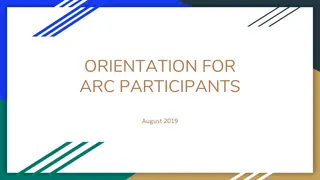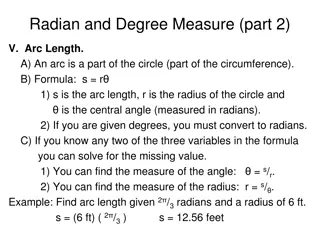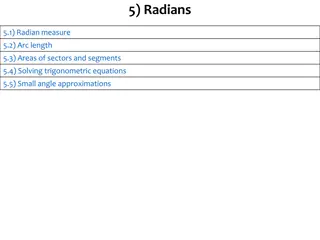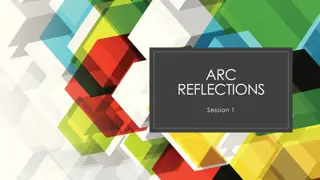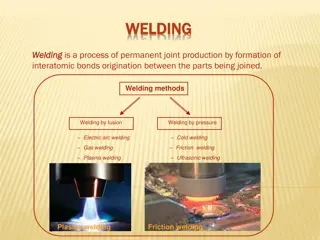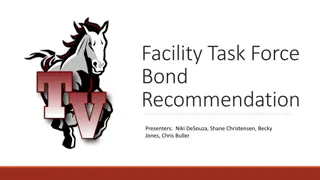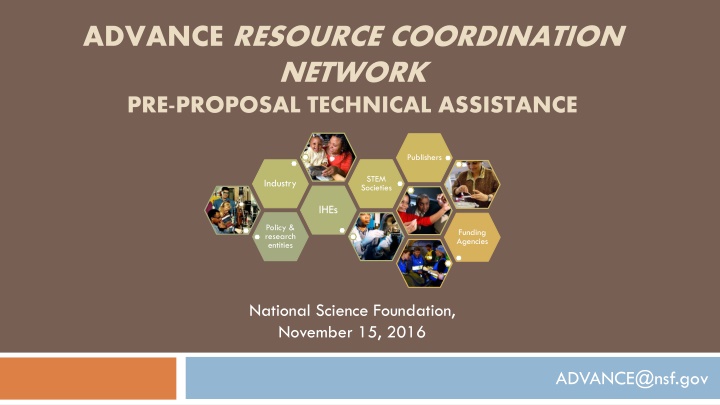
Advancing Gender Equity in STEM: ARC Network Initiatives
Explore the goals and strategies of the ARC Network - a national initiative aimed at advancing gender equity in STEM careers by implementing evidence-based systemic changes in higher education institutions and STEM organizations. Learn about the innovative programs, grant types, and model focal areas contributing to gender equity in academia.
Download Presentation

Please find below an Image/Link to download the presentation.
The content on the website is provided AS IS for your information and personal use only. It may not be sold, licensed, or shared on other websites without obtaining consent from the author. If you encounter any issues during the download, it is possible that the publisher has removed the file from their server.
You are allowed to download the files provided on this website for personal or commercial use, subject to the condition that they are used lawfully. All files are the property of their respective owners.
The content on the website is provided AS IS for your information and personal use only. It may not be sold, licensed, or shared on other websites without obtaining consent from the author.
E N D
Presentation Transcript
ADVANCE RESOURCE COORDINATION NETWORK PRE-PROPOSAL TECHNICAL ASSISTANCE Publishers STEM Societies Industry IHEs Policy & research entities Funding Agencies National Science Foundation, November 15, 2016 ADVANCE@nsf.gov
ADVANCE Program Goals To develop systemic approaches to increase the representation and advancement of women in academic STEM careers To develop innovative and sustainable ways to promote gender equity that involve both men and women in the STEM academic workforce To contribute to the research knowledge base on gender equity and the intersection of gender and other identities in STEM academic careers
ADVANCE Grant Types NSF 16-594 Institutional Transformation (IT) Develop, implement, and study innovative organizational change strategies to foster gender equity Adaptation Adapt proven organizational gender equity strategies Partnership Scale-up proven systemic gender equity strategies for national or regional impact ADVANCE Resource and Coordination Network (ARC) National network to advance gender equity in STEM academics ADVANCE Longitudinal Evaluation (ALE) Study and document indicators of organizational change at past ADVANCE IT institutions
ARC Network Goal The goal is to advance gender equity for STEM faculty nationally by facilitating the adoption and implementation of evidence- based systemic changes by institutions of higher education and other STEM organizations that affect those in STEM academic careers.
ARC Network General Expectations The ARC Network partners are expected to have the range of expertise and the infrastructure needed to implement proposed network activities. Each partner can be working on different components of the network. Strong communication and coordination among partners is expected. The ARC Network is expected to propose a comprehensive program of change to enhance gender equity for STEM faculty in the U.S. The ARC network is not intended to support primary research. The ARC Network is expected to include internal and external evaluation plans.
ARC Network Model Focal Areas Communication Increasing Access Access to gender equity research and its translation into practice by various institution types. Access to research and evidence- based training, tools, and materials for decision-makers including academic administrators, faculty senate leaders, senior faculty, faculty union leaders, STEM research funders, professional societies, etc. Open communication and exchange of information and resources between and among gender equity researchers and research users.
ARC Network Model Focal Areas Building and Developing Coordinating and Maintaining Regular meetings on gender equity in STEM academics designed for broad audiences, including researchers and practitioners particularly past and current NSF ADVANCE grantees. An ARC Network web site (building on existing efforts) employing the creative use of social media. The community of those working to enhance gender equity while also reducing unnecessary duplication of efforts. Community standards for research and evaluation instrumentation, data, and metadata related to gender equity and institutional climate and culture.
Moving Beyond How Weve Always Done Things The proposed ARC Network should: Explain the activities that the network would coordinate in the immediate future and, if applicable, the coordination it would eventually facilitate (e.g., once the appropriate infrastructure is established). Outline the infrastructure needed for the network to accomplish proposed goals and objectives and how that infrastructure will be established (if it does not already exist). Be focused on systemic change that elevates and accelerates change toward greater equity.
Proposal Preparation Proposers should follow the Grant Proposal Guide (GPG (NSF-16)) when preparing and submitting an ARC Network proposal (http://www.nsf.gov). Project Summary: Overview (Project goals, objectives, activities, etc.) Intellectual Merit (Advance knowledge) Broader Impacts (Benefit to society)
Proposal Preparation (continued) Project Description Project goal, rationale, relevant literature, components (with evidence to support need for component activities), and targeted audiences. Network structure: Explain collaborations, shared vs. unique roles and responsibilities, activities, lasting impacts and sustainability to transform. Intellectual Merit and Broader Impacts of proposed activities.
Proposal Preparation (continued) Project Description Results from prior NSF Support: Past 5 years, if more than one, then report award most closely related. Project management: Team, qualifications, roles and responsibilities of all partners. Further information provided on a later slide Dissemination plan for professionals and the public. Project evaluation: Both internal and external assessments Further information provided on a later slide
Additional Proposal Sections STEM Society Industry Policy entities References Cited Biographical Sketch(es) Budget / Budget Justification Current and Pending Support Facilities, Equipment & Other Resources Supplemental Documents Data Management Plan Post-doc Mentoring Plan (if applicable) Documentation of Collaborative Arrangements Letters of commitment from organizational leaders Letters from others decision-making bodies such as advisory boards may also be appropriate for some partnering organizations IRB Documentation (if applicable) External evaluator curriculum vita(s)
Collaborative Proposals Collaborative proposals are encouraged for partners with significant roles and responsibilities. A collaborative includes submissions from each organization with separate project leaders (PIs and co-PIs). All submissions share the same project description narrative but allow for different: Biographical Sketch(es) Budget and Budget Justification (funds go directly to each partner from NSF) Current and Pending Support Facilities, Equipment & Other Resources Each collaborative partner may include sub-awards for other partners.
Budget Details Proposals may request a total budget of $5 million, for an average of $1 million each year for five years (contingent on the availability of program funds) Continued funding in years four and five may be reduced or eliminated if performance is not satisfactory as determined from annual reports and potential site visits.
Project Evaluation STEM Society Industry Policy entities A project evaluation plan is required in the proposal that includes: Formative and summative components Quantitative and qualitative indicators Internal and/or external evaluator (you want objective feedback) Plan should include objectives, goals, and baseline data (these should have already been referenced in your activities description) Evaluation should help you to understand the impact of your project on gender equity: Project-related data and participant evaluations of activities is not sufficient for project evaluation
Project Management STEM Society Industry Policy entities The role of each partner in project implementation and management Plans for partner communication and involvement The role and level of effort of key personnel Project teams should include necessary expertise to implement activities Project timeline with major activities (including evaluation) May include an internal and/or external advisory committee: Committee could include: STEM organization leaders, institutional researchers, STEM faculty and administrators, providers of faculty services, gender equity researchers, and other individuals with needed expertise
Proposal Target Date and Award Information Potential PIs are advised to discuss the ARC Network proposal with the ADVANCE program officers before submitting. Full proposal target date March 15, 2017 NSF anticipates making one ARC Network award Proposals may be submitted by a single non-profit academic institution or a non-profit, non-academic organization located in the US or by a collaborative partnership among intuitions and/organizations. Prior ADVANCE support is not necessary to participate Past or current ADVANCE grant recipients are eligible to participate
NSF Merit Review Criteria Intellectual Merit the potential to advance knowledge. Broader Impacts the potential to benefit society and contribute to the achievement of specific, desired societal outcomes. Both criteria, Intellectual Merit and Broader Impact, will be given full consideration during the review and decision-making processes. Proposers must fully address both criteria.
Merit Review Considerations What is the potential for the proposed activity to: Advance knowledge and understanding within its own field or across different fields (Intellectual Merit);and Benefit society or advance desired societal outcomes (Broader Impacts)? To what extent does the proposed activity suggest and explore creative, original or potentially transformative concepts? Is the plan for carrying out the proposed activities well-reasoned, well- organized, and based on a sound rationale? Does the plan incorporate a mechanism to assess success?
Additional Review Criteria: Intersectionality* All ADVANCE proposals are expected to offer strategies to promote gender equity for all faculty and address intersectionality. *Note the only additional review criterion in this solicitation is focused on this expectation.
Merit Review Considerations How well qualified is the individual, team, or organization to conduct the proposed activities? Are there adequate resources available to the PI (either at the home institution or through collaborations) to carry out the proposed activities? Please Note: Reviewers are also asked to review Facilities, Equipment and Other Resources, Data Management Plan, and Postdoctoral Researcher Mentoring Plan
Resource Coordination Network Examples (SBST) Social and behavioral science coordination network for effective federal government policy implementation: www.sbst.gov (CAISE) STEM education coordination (projects, research and evaluation): http://www.informalscience.org/ (stellar) Capacity building for K-12 STEM participation: http://stelar.edc.org/ (MSPnet) Math and science partnership network for improving STEM http://hub.mspnet.org/index.cfm (ARC) STEM capacity building for instruction/learning, research, cross disciplinary innovation, and dissemination https://arc.uchicago.edu/about-arc (NAPE) National alliance of educators for capacity building in educational access and equity: http://www.napequity.org/ (NIFA) Cooperative extension services model may also provide useful frameworks: https://nifa.usda.gov/partnerships
Thank you! Email questions to ADVANCE@nsf.gov Publishers STEM Societies Industry IHEs Policy & research entities Funding Agencies


